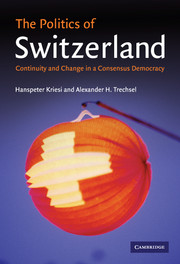Book contents
- Frontmatter
- Contents
- List of figures
- List of tables
- Preface
- List of abbreviations
- 1 The development of the modern Swiss nation-state
- 2 Neutrality
- 3 Federalism
- 4 Direct democracy
- 5 The Swiss system of government
- 6 The party system
- 7 Interest associations and labour relations
- 8 The decision-making process
- 9 Economic policy: liberalization under constraints
- 10 Social policy: the Swiss welfare state
- 11 Foreign policy: Switzerland and the EU
- Appendix
- References
- Index
11 - Foreign policy: Switzerland and the EU
Published online by Cambridge University Press: 05 September 2012
- Frontmatter
- Contents
- List of figures
- List of tables
- Preface
- List of abbreviations
- 1 The development of the modern Swiss nation-state
- 2 Neutrality
- 3 Federalism
- 4 Direct democracy
- 5 The Swiss system of government
- 6 The party system
- 7 Interest associations and labour relations
- 8 The decision-making process
- 9 Economic policy: liberalization under constraints
- 10 Social policy: the Swiss welfare state
- 11 Foreign policy: Switzerland and the EU
- Appendix
- References
- Index
Summary
Introduction
Although Switzerland is at the heart of Europe, the country resembles a tiny island on the political map of Europe, surrounded by the twenty-seven member states of the European Union. In chapter 2 we argued that recent domestic and international developments have altered Switzerland's renowned political-island status. However, its outsider position in EU politics, due to its formal non-membership, prevents the country from full political integration. As we shall see in this chapter, solutions have nonetheless been found that allow Switzerland to deal with the challenges imposed by European integration.
We commence this chapter by providing a historical overview of the relations between the European Union and Switzerland. Structured in four stages, this overview is followed by a discussion of the prospects for eventual EU accession. We will conclude this chapter by arguing that Switzerland's current and probable future relationship with the EU can best be characterized as a ‘customized quasi-membership’.
Historical overview
The historical outline of Switzerland's relationship with the European Community (EC), and later with the EU, can be structured in four, consecutive stages: initial multilateral failures, stagnation, further multilateral failure and enhanced unilateral and bilateral integration.
Stage one: initial multilateral failures (1955–72)
The developments leading to the Treaties of Rome, which created the European Economic Community (EEC; now known simply as the European Community or EC) and the European Atomic Energy Community (EURATOM) in 1957, demanded a Swiss reaction in order to avoid the country's isolation.
- Type
- Chapter
- Information
- The Politics of SwitzerlandContinuity and Change in a Consensus Democracy, pp. 172 - 190Publisher: Cambridge University PressPrint publication year: 2008

